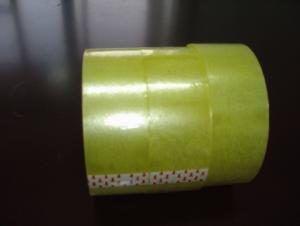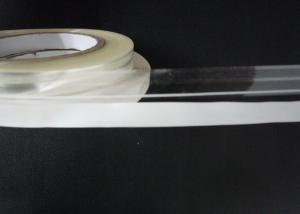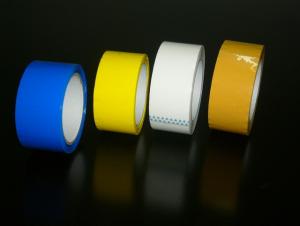Henkel High Quality BOPP Packing Tape 45Micron
- Loading Port:
- China Main Port
- Payment Terms:
- TT OR LC
- Min Order Qty:
- -
- Supply Capability:
- -
OKorder Service Pledge
OKorder Financial Service
You Might Also Like
Product Description:
Quick details:
· Material: BOPP
· Use: Carton Sealing
· Adhesive Side: Single Sided
· Adhesive: Acrylic
· Adhesive Type: Water Activated
· Design Printing: Offer Printing
· Place of Origin: China (Mainland)
· color: clear, super clear, crystal clear, red, blue, brown, yellow, green etc
Specifications:
ItemNo. | Carrier | Adhesive | Total | Initial | Peel Adhesion | Holding | Tensile | Elongation |
BP-40 | BOPP film | water based acrylic | 40 micron | >18# | 0.5kgf/25mm | >24h | >30N/cm | <180% |
BP-45 | BOPP film | water based acrylic | 45 micron | >18# | 0.5kgf/25mm | >24h | >30N/cm | <180% |
BP-50 | BOPP film | water based acrylic | 50 micron | >20# | 0.5kgf/25mm | >24h | >30N/cm | <180% |
BP-65 | BOPP film | water based acrylic | 65 micron | >24# | 7.88N/25mm | >40h | >30N/cm | <180% |
Application:
Bopp tape is mainly for Carton sealing & packing, Light duty packaging, bundling, holding, and other office & household use.
Packing:
Paper Core ID: 76mm
Jumbo size: 1280mm x 4000m; 1625mm x 4000m
Cut roll size: As per customer's requirement
Cut rolls: 6 rolls per shrink, 36/54/72 rolls per carton with or without pallet
Jumbo rolls & log rolls: Packed with kraft paper and stretch wrap film, with or without pallet
- Q: What kind of material is used in this kind of tape? What are its features? How are they made? And so on!The more detailed you write, the better!
- Look, there's no poison. Look at the sticky stuff above. What's that?
- Q: Does packaging tape come in different odor-free options?
- Yes, packaging tape does come in different odor-free options. Many manufacturers offer packaging tape that is specifically designed to be odor-free, making it suitable for use in sensitive environments or for individuals who may have allergies or sensitivities to certain scents. These odor-free options are typically made from materials that do not emit any strong smells or fragrances, ensuring a neutral and pleasant packaging experience. When purchasing packaging tape, it is always a good idea to check the product description or labeling to see if it is specifically mentioned as odor-free.
- Q: Can packaging tape be used for sealing ceramic items?
- Indeed, ceramic items can be sealed using packaging tape. The strength and durability inherent in packaging tape render it a fitting choice for securing and sealing diverse materials, ceramics included. However, it is crucial to bear in mind that packaging tape may not deliver the same degree of protection as specialized ceramic sealants or adhesives. To attain a more reliable and enduring seal, it is advisable to employ a ceramic-specific adhesive or sealant that is specifically engineered to endure the distinctive attributes of ceramics, such as fluctuations in temperature or exposure to moisture.
- Q: Can packaging tape be used for sealing ceramic items?
- Indeed, ceramic items can be sealed using packaging tape. The strength and durability inherent in packaging tape render it a fitting choice for securing and sealing diverse materials, ceramics included. However, it is crucial to bear in mind that packaging tape may not deliver the same degree of protection as specialized ceramic sealants or adhesives. To attain a more reliable and enduring seal, it is advisable to employ a ceramic-specific adhesive or sealant that is specifically engineered to endure the distinctive attributes of ceramics, such as fluctuations in temperature or exposure to moisture.
- Q: Can packaging tape be used for sealing retail or product packaging?
- Yes, packaging tape can be used for sealing retail or product packaging.
- Q: Does packaging tape come in different widths for different applications?
- Yes, packaging tape does come in different widths to cater to various applications.
- Q: What are the benefits of using high-tack packaging tape?
- There are several benefits of using high-tack packaging tape. Firstly, high-tack tape has a stronger adhesive compared to regular packaging tape, ensuring that the tape sticks firmly to the surface it is applied to. This provides a secure and reliable seal for packages, preventing them from opening or getting damaged during transit. Secondly, high-tack tape is designed to withstand various environmental conditions, including extreme temperatures, humidity, and moisture. This makes it suitable for packaging items that may be exposed to harsh conditions during shipping or storage. The tape remains intact and does not lose its adhesion, ensuring the package remains sealed and protected. Additionally, high-tack packaging tape is often thicker and more durable than regular tape, providing extra strength and resistance to tearing or puncturing. This added durability is especially beneficial when shipping heavy or bulky items that require a stronger tape to hold them securely. Furthermore, high-tack tape is typically easy to use and dispense, making the packaging process more efficient. It often comes with a dispenser or is available in easy-to-use formats, such as rolls or strips, reducing the time and effort required to seal packages. Lastly, high-tack packaging tape can enhance the professional appearance of packages. It often comes in clear or transparent options, allowing any logos or labels on the package to remain visible. This can be particularly advantageous for businesses that want to showcase their branding or ensure that important information is easily readable. In conclusion, the benefits of using high-tack packaging tape include superior adhesion, resistance to environmental conditions, durability, ease of use, and a professional appearance. These advantages make it an ideal choice for securing packages and ensuring their safe and secure delivery.
- Q: How does packaging tape differ from masking tape?
- Packaging tape differs from masking tape primarily in terms of their intended uses and adhesive properties. Packaging tape is specifically designed for sealing boxes and packages, providing a strong and durable bond that can withstand shipping and handling. It is usually made of a strong material like polypropylene and has a strong adhesive that sticks well to various surfaces, including cardboard and plastic. On the other hand, masking tape is designed for temporary applications like painting and crafting. It has a less aggressive adhesive that allows for easy removal without leaving residue or damaging surfaces. Masking tape is typically made of paper and is not as strong as packaging tape, making it unsuitable for heavy-duty tasks like sealing boxes for shipping.
- Q: Is packaging tape resistant to chemicals?
- Yes, packaging tape is typically resistant to chemicals. It is designed to withstand various substances and maintain its adhesive properties, making it an effective choice for securing packages and protecting their contents.
- Q: Does packaging tape come in different dispenser designs for ergonomic use?
- Different dispenser designs for ergonomic use are available for packaging tape. Various manufacturers offer dispenser options that are specifically created to provide comfort and ease of use during extended periods of usage. These designs often incorporate features like cushioned handles, ergonomic grips, and adjustable tension control to minimize strain and fatigue on the hand and wrist. Moreover, certain dispensers may possess a lightweight and compact design, making them more manageable and maneuverable. The objective of these ergonomic dispenser designs is to enhance productivity and lower the likelihood of injuries or discomfort commonly associated with repetitive tape dispensing tasks.
Send your message to us
Henkel High Quality BOPP Packing Tape 45Micron
- Loading Port:
- China Main Port
- Payment Terms:
- TT OR LC
- Min Order Qty:
- -
- Supply Capability:
- -
OKorder Service Pledge
OKorder Financial Service
Similar products
Hot products
Hot Searches


























